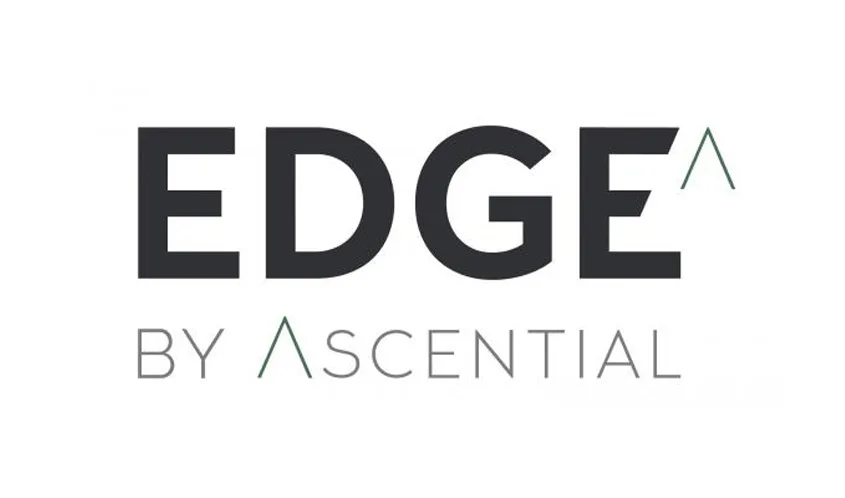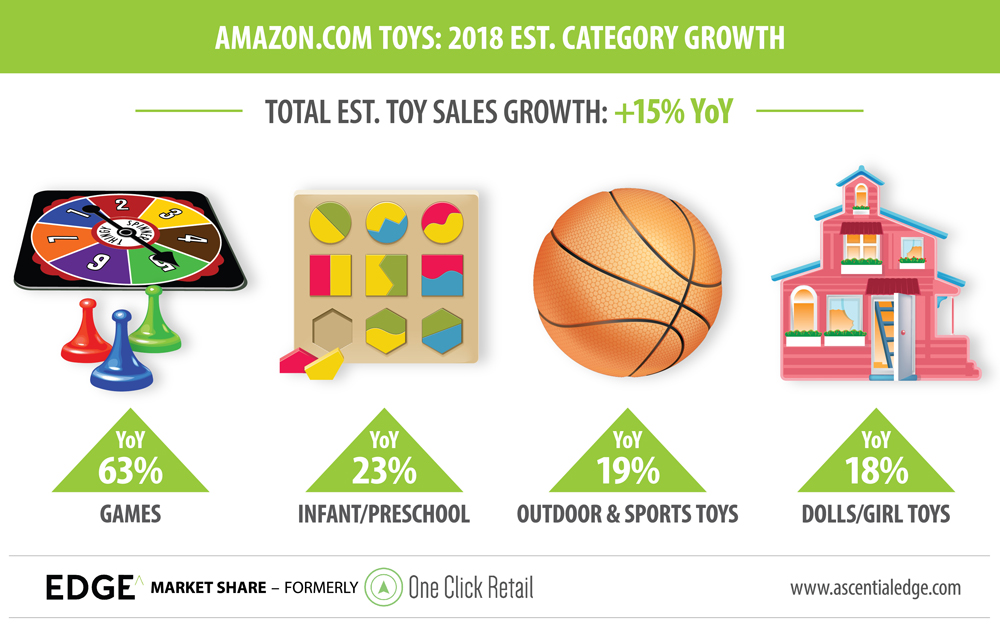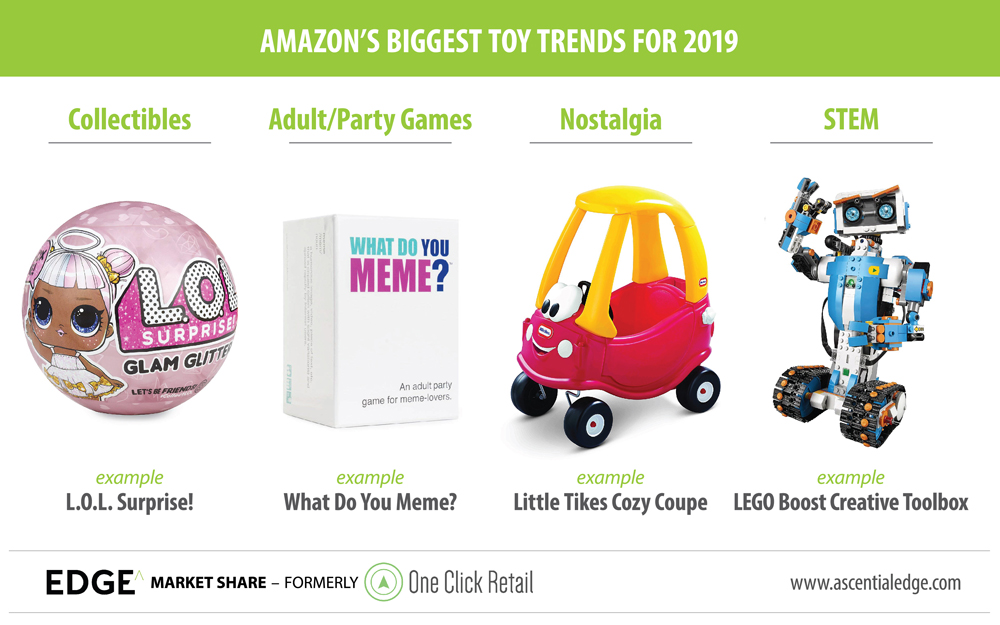by Shyla Navarro, director of e-commerce advisory, Edge by Ascential
When Toys “R” Us shut its doors, the retailer left its 12 percent share of the U.S. toy market up for grabs. Amazon is not one to miss such an opportunity. Ahead of the 2018 holiday shopping season, the busiest time of year for toy sellers, the tech and e-commerce juggernaut mailed out its 70-page toy catalog, “A Holiday of Play,” clearly designed to replace the beloved Toys “R” Us catalog. It also began developing its own line of private-label toys. The result? Amazon.com toy sales were up 15 percent* last year.
The growth was neither uniform nor can be credited entirely to picking up what Toys “R” Us put down. Amazon’s toy categories saw some big swings last year, from games growing by 63 percent year-over-year to construction shrinking by 41 percent. These represent some wider consumer trends—bigger than just a shake-up in the retail landscape—and it all comes down to who is buying the toys—adults.
Though the closure of a major toy institution like Toys “R” Us illustrates the shift to consumers now favoring e-commerce, experiential retail is still important. In fact, it’s arguably experiencing a comeback after the loss of Toys “R” Us, with new independent toy stores popping up across the country. The experience of taking kids to a toy store is something the online channel can never recreate—the value of the old fashioned toy store is in product discovery, while the online channel is preferred for convenience, repeat purchases, and competitive pricing.
Take the collectibles trend for example: We can’t talk about today’s toy market without mentioning L.O.L. Surprise! dolls. The collectible mystery dolls have been one of the fastest-selling toys for years, but they tend to do better in stores than they do online. L.O.L. Surprise! dolls are fun to collect and carry an accessible price point, so it’s easy for kids in stores to convince their parents to buy some. But when parents shop online, they’re less likely to be pressured into buying some flashy, brightly packaged toy and tend to gravitate toward products that have beneficial qualities, be it active play, a social component, or educational/skill-building features.
Amazon is also the preferred channel for adults buying toys and games for themselves. Last year, the games category grew by 63 percent, driven mainly by the popularity of party games—many of which, such as Cards Against Humanity, are not family friendly. Despite the many digital games and entertainment options, adults and parents continue to favor electronics-free social games. The biggest hit last year was What Do You Meme?, an independent, self-released game beating some of the big established manufacturers.
As parents make an effort to reduce their kids’ screen time and encourage more active and constructive play, there is also an element of nostalgia driving toy purchases. Millennials are the last generation to remember the pre-internet age, and many are trying to give their kids the kind of childhood they fondly remember. As a result, the word “classic” became an important keyword in Amazon’s toy category, with toys from the ‘80s and ‘90s making a huge comeback. Toys such as the Little Tikes Cozy Coupe and the Barbie DreamHouse, and board games such as Scrabble, are reverting to classic designs.
The shift toward non-digital play, driven partly by nostalgia, caused some innovative, blockbuster toys like the Anki Cozmo robot to fall in Amazon’s rankings last year, but we do still expect STEM toys and robotics to be an important part of this year’s toy landscape. Consumers are moving away from tie-in products and action figures (entertainment properties declined by 8 percent last year) in favor of learning and exploration.
For example, Amazon’s top toy of 2018 was the LEGO Ideas NASA Apollo Saturn V Building Kit. Parents can encourage an interest in science and engineering in their kids with this product. In recent years, LEGO, with its many franchise licenses, pumped out some very successful tie-in products. Last year, these products began to fade in popularity, replaced by the Ideas product above, the LEGO Boost Creative Toolbox (full title includes “Fun Robot Building Set and Educational Coding Kit for Kids, Award-Winning STEM Learning Toy”), and LEGO Classic.
Today’s young parents are spending less time at the toy store, and the shift in favor of online shopping has a direct impact on the kind of toys they buy. Millennial parents are outcome driven—they don’t just want to keep their kids entertained and occupied. They want to enrich their kids physically, mentally, and socially. As these kids get older, STEM and educational toys will become a key category for mindful parents, and we will see the online channel continue to grow as younger generations become parents.
*Amazon.com Toy category YoY growth figures are estimated based on the most recent available data.
[author] [author_image timthumb=’on’]https://toybook.com/wp-content/uploads/2019/02/Shyla-Navarro.jpg[/author_image] [author_info]Shyla Navarro leads the e-commerce advisory practice at Edge by Ascential, a data, insights, and advisory solution for global brands and retailers looking to win in today’s e-commerce-driven world. She is a toy industry expert and a thought leader in global ecommerce strategy, marketing, and sales.[/author_info] [/author]
This article was originally published in the February 2019 issue of The Toy Book.



